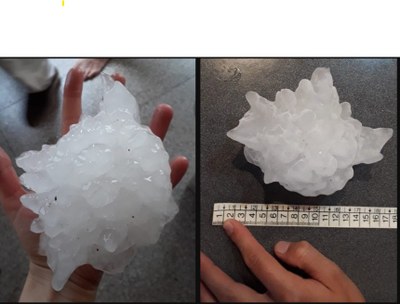
Victoria Druetta plucked the plummeted hail from her yard, then photographed and measured it. COURTESY OF VICTORIA DRUETTA / MATTHEW KUMJIAN
They’re huge, rare, and melting all the time.
IN FEBRUARY 2018, A STORM pelted the Argentinian city of Villa Carlos Paz with hail. The icy balls were really, really big—sometimes bigger than a grown-up’s palm, bumpy as a rock, and hefty enough to imperil people and property. The largest of these might even best the biggest on record: an icy behemoth that tumbled down in Vivian, South Dakota, in June 2010, spanning eight inches and weighing more than a pound. In a new paper in the Bulletin of the American Meteorological Society, an international team of 10 researchers argues that some of the Argentinian hailstones were so off-the-charts humongous that they might need new, oversized terminology. A local teenager, Victoria Druetta, put on a motorcycle helmet to protect her head, retrieved a seven-inch specimen from her yard, measured it, and stored it in her family’s freezer. Another hailstone disappeared before researchers could measure it directly, but video footage helped them estimate its size at between 7.4 and 9.3 inches wide.
Read the full article here:

